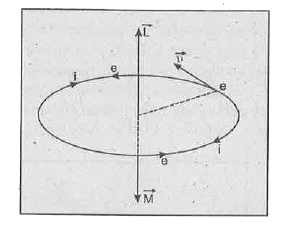Discuss atom as a magnetic dipole. Hence define Bohr magneton.
Atom as a Magnetic Dipole
Every atom consists of a central part, called nucleus, where the entire mass and positive charge of the atom are concentrated. An equal number of negative charges (i.e. electrons) revolve around the nucleus in circular orbits.
The revolution of electron i.e., negative charge in anticlockwise direction is equivalent to conventional current I in the clockwise direction. The upper face with clockwise current acts as south pole and the lower face acts as north pole. Thus an electron revolving in an orbit is equivalent to a magnetic dipole.

Suppose e is the charge on an electron revolving in a circular orbit of radius r with a uniform angular velocity, ω.
If T is the time period of revolution of the electron, then
Current = chargetime
or I=eT
= e2π/ω (∵T=2πω)
or I=eω2π ...(1)
If M is the magnetic dipole moment of the magnetic dipole
M = IA
Using (1), and putting A=πr2, we get
M=eω2ππr2
M=12eωr2 ...(2)
Relation between orbital angular momentum and magnetic dipole momentum.
Because of orbital motion, the revolving electron has an orbital angular momentum L given by
L=mvr=mrωr=mωr2
∴ From (2),
M=12emmωr2
M=12emL
In vector form,
→M=−(e2m)→L ...(3)
This shows that like →L, magnetic dipole moment →M of the atom is perpendicular to the plane of the orbit.
Negative sign shows that direction of →M is opposite to the direction of →L , as is clear from the figure.
According to Bohr.s theory, an electron cannot revolve in any orbit it likes. It can revolve only in those orbits for which the total angular momentum is an integral multiple of h/2π, where h is the Planck.s constant i.e.
Angular momentum of the electron,
L=nh2π
or mr2ω=nh2π
(angular momentum, L=mv×r=mrω×r=mr2ω)
where n = 1, 2, 3, ........
∴ r2ω=nh2πm ...(4)
From (2) and (4),
M=e2⋅nh2πm=n⋅eh4πm=nμB ...(5)
It is obvious that eh4πm is the least value of the magnetic moment. (μB=9.27×10−24JT−1orAm2).
Bohr Magneton
It is defined as the magnetic dipole moment associated with an electron due to its orbital motion in the first orbit of hydrogen atom.
Topper's Solved these Questions
- MAGNETISMBOOK - MBD -HARYANA BOARDCHAPTER - MAGNETISMEXERCISE - OBJECTIVE TYPE QUESTIONS
17 Videos
- MAGNETISMBOOK - MBD -HARYANA BOARDCHAPTER - MAGNETISMEXERCISE - SHORT ANSWER TYPE QUESTIONS
4 Videos
- ELECTROSTATICSBOOK - MBD -HARYANA BOARDCHAPTER - ELECTROSTATICSEXERCISE - OBJECTIVE TYPE QUESTIONS
23 Videos
- MODEL TEST PAPER (SOLVED)BOOK - MBD -HARYANA BOARDCHAPTER - MODEL TEST PAPER (SOLVED)EXERCISE - LONG ANSWER TYPE QUESTIONS
6 Videos
Similar Questions
Knowledge Check
The correct value of Bohr magneton is
A9.27×10−24Am2B9.27×1024Am2C9.27×10−24Am−2D9.27×1024Am−2What is the correct value of Bohr magneton?
A8.89×10−24Am2B9.27×10−24Am2C5.56×10−24Am2D9.27×10−28Am2What is the correct value of Bohr magneton?
A8.89×10−24Am2B9.27×10−24Am2C5.56×10−24Am2D9.27×10−28Am2
Assume that each iron atom has a permaanent magnetic moment equal to 2 Bohr magnetons (1Bohrmag≠→nequals9.27×10−24Am2). The density of atoms in iron is 8.52×1028a→msm−3. (a) Find the maximum magnetization I in a long cylinder of iron. (b) Find the maximum magnetic field B on the axis inside the cylinder.
View SolutionAssume that each iron atom has a permaanent magnetic moment equal to 2 Bohr magnetons (1 Bohr magneton equals 9.27×10−24Am2). The density of atoms in iron is 8.52×1028 atoms m−3. (a) Find the maximum magnetization I in a long cylinder of iron. (b) Find the maximum magnetic field B on the axis inside the cylinder.
View SolutionThe value of the magnetic moment of a particular ion is 2.83 Bohr magneton. The ion is :-
View SolutionThe value of the magnetic moment of a particular ion is 2.83 Bohr magneton. The ion is :-
View SolutionWhat is ratio of Bohr magneton to the nuclear magneton?
View Solution
